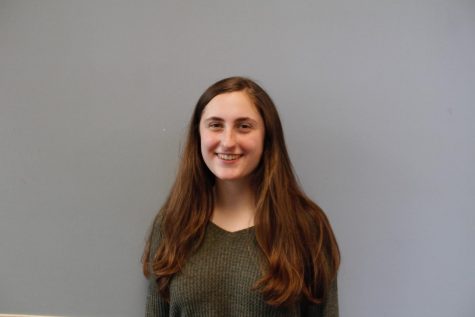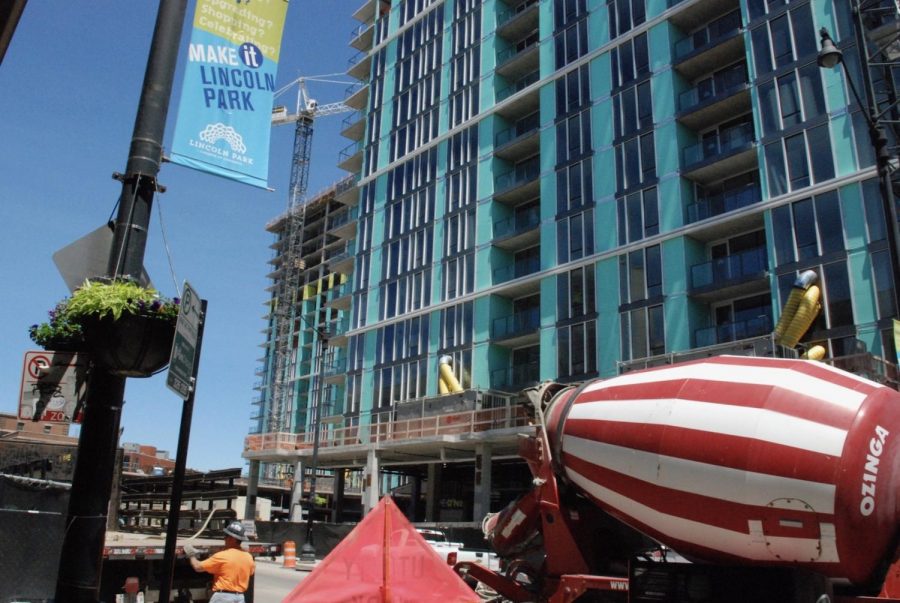Neighborhood at a Crossroads
Lincoln Park Developments to Increase Population Density and Businesses
Photo credit: Sofia Brown
Two years before the old Lurie Children’s Memorial Hospital neared its 2012 closing, developers vying for the opportunity to transform the six acre lot submitted proposals outlining their vision of what it could become.
Now, construction is over halfway complete for the Lincoln Common, a mixed-use development with buildings at the intersections of Lincoln Avenue with Fullerton Avenue and Halsted Street, as well as another at the corner of Fullerton and Orchard Street. Just three blocks from Parker, it will be the tallest and most dense in the area with two 20 story, 500 unit apartment towers that will be filled next June, as well as retail space, dining, offices, green space, and a senior living facility.
This summer, a number of developments that could impact the neighborhood and the day-to-day of Parker students, families, and faculty, neared completion or were completed. The Elevate luxury apartments at 930 W. Altgeld Street, which opened in July, the Duet apartment buildings at 904 and 909 W. Montana Street, and a commercial center at the intersection of Clark Street and Diversey Parkway are just a few that will increase the population, number of visitors, and business opportunity of Lincoln Park.
“There’s a lot of interest in our area,” Director of Zoning and Urban Development for the 43rd Ward, Joana Zaidan, said. “These developments will bring us a mix of more up-to-date, modern commercial spaces, creating a balance with the existing, often times smaller and less expensive spaces.”
Having more residents and visitors will increase foot traffic which may help local businesses succeed and prompt further developments, according to Zaidan. She noted that there’s potential for vacant lots on Clark Street to become occupied, as greater population density would require more businesses that support people’s daily needs.
For Parker, these properties have been a subject of concern that the administration has raised with Alderman Michele Smith. “We have over a thousand people coming to campus every day, and we’re surrounded by empty storefronts,” Vice Principal Ruth Jurgensen, who attends regular Parker-hosted constituent meetings with Smith, said. “What’s going on is a question we’ve had.”
Some worry that significantly increasing density will be detrimental to Lincoln Park for reasons including new traffic and a strain on public schools to serve a larger body of students.
Jurgensen said the Lincoln Common may contribute to traffic congestion around the school, which is already an issue.
“What will it do to getting to and from school?” Jurgensen said. “As drop-off traffic increases, you can see people becoming more aggressive in their driving.” She described an incident that occured this year where a CTA bus didn’t stop at a crosswalk near Parker “because of urgency getting through traffic, which moves slower around the school.”
According to Zaidan, the Lincoln Common’s proximity to the Fullerton “L” station will allow people to use public transportation, and vibrant streets will encourage people to walk instead of drive, which should mitigate additional traffic that the development would create.
Melissa Macek is the president of the Mid-North Association, a community volunteer group that evaluates proposed building projects and advocates that they follow landmark guidelines in order to “preserve the historical character and charm” of Lincoln Park’s Mid-North section, bounded by Lincoln, Lincoln Park West, Fullerton, and Ogden Ave.
According to Macek, Mid-North opposed the Lincoln Common because its population density and height were unprecedented in the area composed mostly of two or three story buildings.
“The city should’ve prevented it based on some of the precedents around the neighborhood,” Macek said. “We felt the city didn’t follow its own rules.”
Zaidan said that the Lincoln Common is classified as a “planned development,” instead of a standard “as of right” one, which falls in line with the city’s code. Instead, the Lincoln Common’s magnitude and impact necessitated that it undergo a more rigorous approval process, which involved creating precise, detailed blueprints and agreeing to regularly communicate with residents throughout construction.
It took three years for Chicago’s Planned Commission to say yes to real estate companies McCaffery Interests and Hines in 2014. — f First came discussions with Smith, meetings with residents, and revisions to design based on their feedback. For example, according to developer Malcolm Craig, at first the apartment towers were intended to be around 30 stories.
Macek said that the altered height is still too tall, as it could set a precedent for future developments that would change the feel of the neighborhood.
“Once those towers go up, people can say ‘Well, I also want to build something that tall,’ and they can look at the Lincoln Common as setting the precedent,” Macek said. “Once you have a whole row of high rises, it’s not going to feel like Lincoln Park anymore––it’s going to feel like you’re downtown.”
It’s unlikely that many buildings with a similar height to the Lincoln Common will be constructed in the area, according to Zaidan. She said the property is unique, acting as an “anchor” at a busy intersection. Also, “it’s not common to find a such a large site” where an as-of-right “floor area ratio,” an appropriate floor surface area relative to the area of the lot and the height of the proposal, would allow for a building taller than average.
Being branded as “the new crossroads of Lincoln Park,” the towers will house over 700 residents, who, according to Craig, will bring economic support to surrounding businesses. Nearby establishments were affected by the loss of hundreds of daily customers who visited the hospital before it relocated. Craig said the Lincoln Common “will bring new life to Lincoln Avenue.”
For sophomore Julia Auerbach, a Lincoln Park resident, the Lincoln Common’s amenities will be beneficial. “I’ve heard there’s going to be an Equinox gym and a grocery store,” Auerbach said. “It would be convenient to have a grocery store because there’s not one nearby that’s easy to walk to.”
Parker parent and Lincoln Park resident Lisa Ehrhart said that while the Lincoln Common may worsen traffic, overall it’s a positive addition to the neighborhood that will be “bustling and exciting.”
Macek agrees that developments can help local businesses thrive, but only if they’re done correctly. “It has to be the right development, in the right place.”








